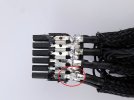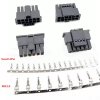DegustatoR
Legend
It was the case with 12VHPWR as well. Not sure why people think that the wires are connecting to pins directly. They are being fused into one common rail inside the connector and this common rail is then connected to the pins.Huh, apparently the design guides for 12VHPWR connectors have been silently changed when relabeling to 12V-2x6, and you are now expected to have a metal bridge on both ends of the wire before going into the connector on either end...
Which also brings up an interesting question about the specs of the wires - is it provided by the plug spec or is it completely up to the cable maker to decide how many wires and with which characteristics should a cable has? I haven't looked this deep into the specs.
Exactly. Which is why the spec requires a bridge of all wires in the plug. So it is unclear how exactly these results from Der8auer even happen - they should only be possible if the bridge is missing or damaged.But it's seriously dangerous if they are bridged only on the PCB side and the bridge on the wire side of the connector is missing. Then you end up with the wires burning.




